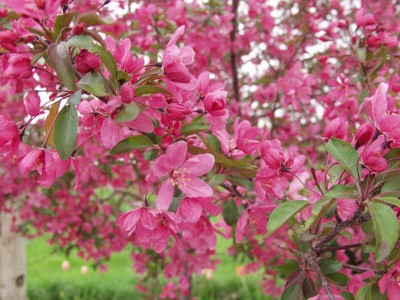Praififire Flowering Crabapple Tree
Category: Deciduous Trees

Facts about Prairifire flowering crabapple tree, "Scientific name for Prairifire flowering crabapple tree is Malus Prairifire". Prairifire flowering crabapple tree common name is flowering crabapple and it is a deciduous tree. It is normally dense and rounded. The Prairifire flowering crabapple tree belongs to the family of rosaceous and its growth rate is medium. It grows to a height of 15 to 20 feet (4.57 to 6.09 meters) spreading at the same level. Zone 3-8 is ideal for its proper growth.
Just as many Prairifire flowering crabapple trees from this family, Prairifire flowering crabapple tree does well in loam, acidic, moist and well drained soils for full development. However, it does well in all other soils as long as they are fertile. Full sun is what is recommended.
The Prairifire flowering crabapple tree requires medium water to grow. After planting it is good to water it until it is fully established. Later it can survive on its own.
Pruning is done in May going all the way to June. This is after flowering and before flower buds are formed for the next year.
Prairifire flowering crabapple tree leaves are made up of many colored pigments, green chlorophyll hides the colors during the growing season of spring and summer. As days get shorter and cooler temperatures come in the fall, it cause the chlorophyll to break down and than the other color pigments can be seen.
Prairifire flowering crabapple tree growth is referred to as Meristem (The undifferentiated embryonic plant tissue from which new cells are created, as that at the tip of a root or stem). This tissue can be found at the tips of shoots and leaves. Inside the stem growth in thickness occurs at the vascular cambium.
Prairifire flowering crabapple trees make their own food from sunlight, carbon dioxide, water, and nutrients from the soil.
Red buds that are pinkish in color open to a deep pink red flowers which are around 1/2 inch (1.27 cm) diameter in spring. Later small purplish-red crabapples come after the flowers are formed. These crabapples mature in the fall and are around 1 1/2 inches (3.8 cm) in diameter. Bloom time occurs in April and May.
The bark of the Praififire Flowering Crab Tree is red-brown in color. It normally looks very handsome. Ovate leaves usually emerges purplish in spring then matures to dark shade of green-reddish tinged leaf veins. The Prairifire flowering crabapple tree is loved by butterflies and birds which seem to attracted by its nectar. They rely on this tree for both food and shelter.
A Full grown Prairifire flowering crabapple tree can absorb as much as 48 pounds (21.77 kg) of carbon dioxide a year. The same Prairifire flowering crabapple tree could also produce enough oxygen in a day for two people.
You can tell a Prairifire flowering crabapple trees age by the number of growth rings inside. Growth rings size shows what kind of conditions accrued that year, the temperature and if it was a dry or wet year.
Bark of the Prairifire flowering crabapple tree protects it from the elements and is made up of dead cells.
Prairifire flowering crabapple tree roots usually grow two to three times the width of the tree branches. The ideal time to fertilize your Prairifire flowering crabapple tree is in late fall or early spring. If you want to transplant a tree do it in fall, this is ideal for most trees.
Prairifire flowering crabapple tree has a high disease resistance. The insects and pests that attack this tree are tent caterpillars, aphids, Japanese beetles, borers and scales. Spider mites are also a nuisance.
Since Prairifire flowering crabapple trees are tolerant to air pollution, this tree is planted as a street tree. It can also be planted in gardens but pruned to a small tree. It is produces good results as a specimen or in groups.

 Back To Category Deciduous Trees
Back To Category Deciduous Trees